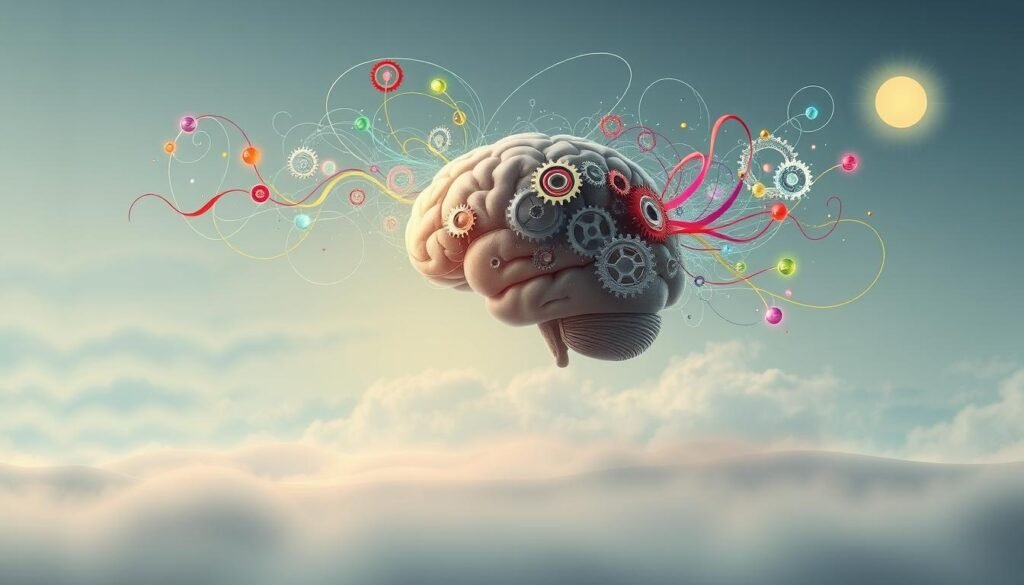Did you know cognitive behavioral therapy (CBT) lowers depression in one-third of those struggling with it and obesity? Studies show a 32% success rate in people using problem-solving therapy. This is much higher than the 17% success rate in those treated with antidepressants only. This fact underlines the strong effect of CBT as a science-backed psychotherapy method.
CBT combines thought process examination with behavior change techniques. It helps people see how their thoughts affect their feelings and actions. This understanding leads to better mental health. Thanks to lots of research, CBT is a top method for treating many mental health issues. Patients usually have between 6 to 20 sessions. They learn to question negative thoughts and take an active role in getting better.
Key Takeaways
- CBT reduces depression in one-third of patients with obesity.
- Response rate for problem-solving therapy is significantly higher than that for antidepressants.
- CBT sessions typically range from 6 to 20, focusing on present thoughts and behaviors.
- Extensive research supports CBT as a leading evidence-based psychotherapy.
- Active patient participation is crucial for the effectiveness of CBT.
Introduction to Cognitive Behavioral Therapy (CBT)
Cognitive Behavioral Therapy, or CBT, is a focused therapy for various mental challenges. It has shown success for anxiety, depression, and issues in relationships. It involves working together with a therapist, focusing on current thoughts and actions rather than past events.
CBT teaches people to identify and challenge negative thoughts. Through introduction to CBT, one learns to change how they think and feel. Studies show that CBT greatly improves people’s lives and functioning.
- Empowering individuals to become their own therapists through assigned exercises and homework.
- Changing detrimental thinking patterns and behavioral responses.
- Focusing on the development of effective coping strategies relevant to present circumstances.
- Utilizing a variety of methods including role-playing and problem-solving exercises.
CBT is a valuable alternative to medication for many. While the therapy sessions range from 5 to 20, the benefits last much longer. People learn skills that help them beyond their initial problems.
| Issue Addressed | Effectiveness of CBT |
|---|---|
| Depression | High |
| Anxiety Disorders | Comparable or superior to other therapies |
| Substance Use Problems | Positive outcomes |
| Eating Disorders | Effective in managing symptoms |
| Marital Problems | Improvement in relationship dynamics |
CBT does more than just solve immediate problems. It gives people the tools to tackle future challenges better. This makes it incredibly valuable for lasting mental health improvement.
Key Principles of Cognitive Behavioral Therapy
The core principles of CBT show that our psychological issues come from negative thinking and deep-rooted habits. This method helps people find new ways to cope, improving how they function each day and lessening bad feelings.
CBT uses organized sessions that help clients see and change their warped thinking. It focuses on solving problems, helping individuals deal with their issues directly.
Therapists work closely with their clients, making therapy plans that fit each person. They ensure clients are actively involved and receive support during therapy. This teamwork creates a safe space for exploring thoughts and emotions.
CBT is flexible and respects everyone’s background, making therapy fit the person. As therapy moves forward, therapists adjust their plans. This helps clients get better mentally.
| Core Principle | Description |
|---|---|
| Understanding Thoughts | Recognizing the role of thoughts in emotional responses and behaviors. |
| Behavioral Change | Implementing new behavioral strategies to replace harmful patterns. |
| Problem-Solving | Applying structured approaches to tackle specific issues faced by clients. |
| Self-Reflection | Encouraging personal insight into one’s thoughts and actions. |
| Coping Mechanisms | Teaching effective strategies to manage stress and anxiety. |
Cognitive Behavioral Therapy is a trusted method for mental health issues. It guides people towards healing and gaining control over their lives.
Understanding Cognitive Distortions
Cognitive distortions shape how we think and feel. They turn our thoughts negative, changing how we see life. Learning about these patterns is key to healthier thinking habits.
Cognitive Distortions Explained
Aaron Beck and his team introduced cognitive distortions in the 60s and 70s. They outlined ten main types. These patterns can worsen mental health issues like depression. Stressful events or tough childhoods can trigger these thoughts. It’s important to deal with them in therapy.
Examples of Common Cognitive Distortions
Knowing the common patterns helps us fight irrational thoughts. Examples include:
- All-or-nothing thinking: Seeing things in just black or white.
- Overgeneralization: Making broad judgments from little evidence.
- Catastrophizing: Always expecting disaster.
- Personalization: Blaming yourself for everything.
- Labeling: Giving yourself or others negative tags.
A study in 2021 linked these thoughts to depression. Cognitive Behavioral Therapy (CBT) helps change these beliefs. It teaches better responses to life’s challenges. To learn more about CBT techniques, click here.
| Cognitive Distortion | Definition | Impact on Mental Health |
|---|---|---|
| All-or-nothing thinking | Seeing things in extremes; no middle ground. | Can lead to feelings of failure or hopelessness. |
| Overgeneralization | Basing conclusions on a single event or limited evidence. | May cause despair and self-doubt. |
| Catastrophizing | Expecting the worst possible outcome. | Leads to heightened anxiety and stress. |
| Personalization | Blaming oneself for events outside one’s control. | Can foster guilt and shame. |
| Labeling | Assigning negative labels to oneself or others. | Encourages a fixed, negative self-image. |
Cognitive Restructuring as a Core Technique
Cognitive restructuring is key in cognitive behavioral therapy, or CBT. It aims to change negative thoughts in a planned way. It’s essential for improving mental well-being.
The Process of Cognitive Restructuring
There are several steps in this process. They help people spot and question wrong thinking. First, one must see the bad thoughts that make them feel down.
Then, they check these thoughts’ truth and swap them for better ones. Tools like self-watch and questionings help in this shift. This method doesn’t just change thoughts but also boosts emotional health.
Benefits of Cognitive Restructuring
Using cognitive restructuring has many benefits. It lessens mental pain and builds self-worth. It gives people better ways to handle life, improving mental health.
Research proves it works for issues like anxiety and depression. It leads to a hopeful view and better handling of life’s problems. Learning from experts can help people adopt positive thoughts. Those who want to know its effectiveness can find solid information here.

Emotion Regulation and Its Importance in CBT
Emotion regulation is key in Cognitive Behavioral Therapy (CBT). It helps people make big changes in therapy. It’s about how we control our emotions. This control can lower stress and make coping easier. Thoughts, feelings, and actions are all linked in managing emotions well.
How Emotion Regulation Works
There are different levels and types of emotion regulation. They can be something we do on our own or with others. They can also be automatic or something we control. In CBT, using these strategies makes therapy work better.
Studies link better therapy results to good emotion regulation strategies. But, theories in therapy don’t always mix well. For example, psychodynamic therapy (PDT) and CBT take different views on how to handle emotions. PDT looks at defense and inner feelings. CBT focuses on how to cope and correct emotions.
In one study, people with anxiety learned to think differently about their emotions. After 10 CBT sessions, their brain activity changed. This showed less reaction to negative emotions. It shows why knowing about emotion regulation matters in CBT for mental health treatment.
Getting good at managing emotions helps with anxiety and better relationships. It makes people think in healthier ways. This ability helps them face life’s ups and downs. If you’re interested, you can learn more about how emotional regulation affects memory at this link.
| Emotion Regulation Approach | Focus Area | Key Strategies |
|---|---|---|
| Psychodynamic Therapy (PDT) | Defense mechanisms, internal models | Therapeutic containment, understanding defenses |
| Cognitive Behavioral Therapy (CBT) | Coping strategies, emotional experiences | ABC model, cognitive reappraisal |
The Role of Neuroplasticity in CBT
Neuroplasticity shows how our brains can change throughout our lives. This change is key for Cognitive Behavioral Therapy (CBT). People using CBT learn new ways of thinking and acting. These new habits can change their brain’s structure and how it works.
Neuroplasticity Defined
Neuroplasticity is when the brain changes because of new experiences and learning. CBT uses this to help people change bad thoughts. This can make people better at controlling their feelings and improve mental health.
Implications for Mental Health and CBT
Neuroplasticity has a big impact on mental health. Studies show CBT can change the brain, especially the amygdala that handles emotions. This can make people with social anxiety have a smaller amygdala. It makes them less scared and better at handling emotions.
CBT gives more than short-term relief unlike medications. It builds new pathways in the brain. This gives people tools and ways to deal with tough situations. The Lukin Center uses CBT and understands how it helps through neuroplasticity.
The Science Behind Cognitive Behavioral Therapy (CBT)
Cognitive Behavioral Therapy (CBT) is a well-known type of mental health treatment. It is backed by a lot of clinical practice evidence. This approach helps with many mental health issues. It has become more popular because it is structured and the results can be measured. This has made both doctors and patients more willing to use it.
In the year 2020-21, there were 1.46 million people referred for talking therapies. This was a bit less than the 1.69 million the year before. Still, more people finished their treatment this time – an increase of 4.6%. It shows that more people are seeing the benefits of CBT. During this time, 51.4% of those referred made progress towards recovery.
On average, people are now going to more sessions than before – up to 7.5 from 6.9. This shows that they are really giving therapy a chance. And it shows that CBT works well in helping people change their behavior by changing the way they think.
Studies using fMRI technology have shown that CBT can change how the brain works. These changes are seen in areas that control our emotions and thoughts. This is proof that CBT not only helps people act differently but can actually change the brain. This research helps us see how powerful our minds are and how CBT can help change them.
| Statistic | 2020-21 | 2019-20 | Change |
|---|---|---|---|
| Total Referrals | 1.46 million | 1.69 million | Decrease of 14.0% |
| Referrals Completing Treatment | 634,649 | 606,192 | Increase of 4.6% |
| Recovery Rate | 51.4% | 51.1% | Increase of 0.3 percentage points |
| Average Sessions Completed | 7.5 | 6.9 | Increase of 0.6 sessions |
Exposure Therapy and Its Effectiveness
Exposure therapy is a key part of cognitive-behavioral therapy. It helps people with anxiety face their fears in a controlled way. This method slowly exposes people to what they fear. This reduces their anxiety over time. The success of exposure therapy comes from teaching people to deal with their fears in a safe space.
Mechanism of Exposure Therapy
At its core, exposure therapy works by exposing people to what scares them, again and again. This could mean facing fears through imagination, real-life situations, or physical sensations. After about ten sessions, people start to handle their anxiety better. Their fear starts to lessen. Studies show this therapy doesn’t just help manage anxiety. It also builds resilience, helping people overcome obstacles they once feared.
Application in Anxiety Disorders
Exposure therapy is very effective for treating various anxiety disorders. This includes PTSD, OCD, and specific phobias. Reviews of studies support this therapy’s effectiveness. It often works better than other methods. For people with anxiety disorders, it offers a clear path to improvement. It proves facing fears directly can greatly reduce symptoms.

Mindfulness Techniques in Cognitive Behavioral Therapy
Recently, mixing mindfulness with cognitive behavioral therapy (CBT) has shown great results for mental health. Mindfulness teaches us to be aware of the present moment without judging our thoughts or feelings. This helps people understand their emotions and thoughts better. It leads to better control of emotions and decreases anxiety and depression.
Mindfulness-Based Cognitive Therapy (MBCT) is a key example. It cuts the chance of depression coming back by almost half. It works for different types of people, regardless of age, sex, or relationship status. Studies prove it’s as good as antidepressant medicines in stopping depression from returning. This makes it a trusted method in psychology.
MBCT has an eight-week program with two hours of class each week. After five weeks, there’s a whole day of learning. This helps participants grow stronger emotionally and understand their feelings better. It’s a big help in improving mental health.
Studies keep showing the success of mindfulness-based treatments. They work better than treatments without strong evidence to back them up. Both Mindfulness-Based Stress Reduction (MBSR) and MBCT effectively tackle mental health challenges. They significantly lower anxiety and depression.
The following table summarizes key benefits associated with mindfulness techniques in CBT:
| Benefit | Description |
|---|---|
| Enhanced Psychological Resilience | Strengthens individuals’ ability to cope with stress and challenges. |
| Decreased Stress and Depression | Reduces overall levels of anxiety and depressive symptoms. |
| Improved Self-Awareness | Heightens consciousness of thoughts and feelings, encouraging positive change. |
| Increased Concentration | Helps enhance focus and attention in daily tasks and activities. |
| Enhanced Self-Esteem | Fosters a positive self-image and self-compassion. |
Evidence-Based Nature of CBT
Cognitive Behavioral Therapy (CBT) is a well-researched form of therapy. It’s focused and goal-driven, aiming to solve various mental health issues. CBT sessions usually last between six to twenty meetings, making the most of time for effective treatment.
CBT is known for its success in treating anxiety and depression. It’s flexible, effective against a range of conditions like bipolar disorder and eating disorders. This adaptability makes CBT useful from phobias to schizophrenia.

There’s a significant amount of research backing CBT’s success. From 1987 to 2021, 345 articles were reviewed. Out of these, 15% were clinical trials, with 45 being randomized controlled ones. These studies prove that CBT offers both immediate and long-lasting benefits, especially for disorders like obsessive-compulsive disorder.
Some people see major improvements after just four to six sessions of CBT. Its focus on practical skills helps in everyday life, making it a strong choice for mental health care. Highlighting its scientific backing, CBT stands as a fundamental part of psychotherapy. It is a true example of evidence-based practice.
Coping Strategies Utilized in CBT
Cognitive Behavioral Therapy (CBT) offers many coping strategies to help individuals better their mental health. These strategies enable people to face mental challenges head-on. Techniques like cognitive restructuring help spot and change negative thoughts into positive ones, leading to better behavior.
CBT uses exposure therapy to help people confront their fears bit by bit. This method decreases fear and builds long-term coping skills. Techniques to relax and reduce stress, such as deep breathing and visualization, are also key. They help control emotions and lessen anxiety.
Learning therapeutic techniques in CBT makes dealing with life’s problems easier. It’s important to practice these methods at home too. This extra practice helps strengthen skills needed for managing emotions and bouncing back from tough situations. With these coping strategies, individuals gain the confidence to overcome obstacles. This leads to a happier life.
Conclusion
Cognitive Behavioral Therapy (CBT) stands out as a key method in mental health therapy. It is well-researched and has been shown to help with many mental health issues. These include eating and anxiety disorders, PTSD, and mood issues. CBT works by changing how we think. It helps people see and alter negative beliefs that affect their feelings. This method is about working together. Clients play an active part in their healing, both in and out of therapy sessions.
CBT is flexible and has led to new therapies like dialectical behavior therapy. It also helps when it’s used with medication for tough cases like major depression. The importance of starting treatment early and making it fit the individual is clear. This conclusion on CBT highlights the role of tailored care in better recovery.
The outlook for CBT is bright, with more research backing up its success. It can be a powerful set of tools for managing emotions. CBT encourages people to take an active role in getting better. It supports clients on their path to mental health and stability.